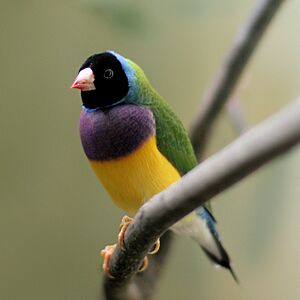Wyndham Important Bird Area facts for kids
The Wyndham Important Bird Area is a special place for birds in the north-east of the Kimberley region in Western Australia. It covers about 28 square kilometers (about 11 square miles) of land. This area is found in the Bastion Hills, which are close to the town of Wyndham. Wyndham is a port town located on the West Arm of the Cambridge Gulf. This site is very important because it is a key home for Gouldian finches.
About the Area
This bird area has gentle hills and open woodlands mixed with grasslands. You'll find many eucalypt trees here, some of them very old, with hollows perfect for finches to build their nests. The grasslands provide plenty of food for the birds. Plus, being close to Wyndham means the birds have a reliable source of drinking water.
The weather here is a tropical monsoon climate. This means it's usually warm or hot. The coolest month is July, with temperatures around 17°C (63°F). The hottest month is November, where it can reach 40°C (104°F). Most of the rain, about 780 mm (30 inches) each year, falls between November and March.
Amazing Birds
The Wyndham Important Bird Area has been named an Important Bird Area (IBA) by BirdLife International. This is because it is home to the biggest known group of endangered Gouldian finches. These beautiful birds are quite rare, so protecting their home is very important.
Besides the Gouldian finches, you can also find other cool birds here, such as:
- northern rosellas
- white-gaped honeyeaters
- yellow-tinted honeyeaters
- bar-breasted honeyeaters
- silver-crowned friarbirds
- masked finches
- long-tailed finches
- yellow-rumped munias
Finch Trapping History
For many years, people used to catch finches in the wild, especially in the Kimberley region around Wyndham. This practice, called finch trapping, started around 1897. The birds were often sent overseas to places like Europe.
Over time, people realized that catching so many birds could harm their populations. Because of this, laws were slowly put in place to protect the finches. By 1902, some protection began in Western Australia. Later, in 1960, it became illegal to export live Australian animals for business reasons.
The trapping of certain finches stopped even earlier. For example, the yellow-rumped mannikin was protected after 1975 because it became scarce. The Gouldian finch, which was seeing a decline in its numbers, was protected from trapping after 1981. Finally, on November 15, 1986, all finch trapping in the Kimberley was officially banned to help protect these amazing birds. Australia also joined an international agreement called CITES (Convention on International Trade in Endangered Species) to help control the trade of endangered animals and plants.


